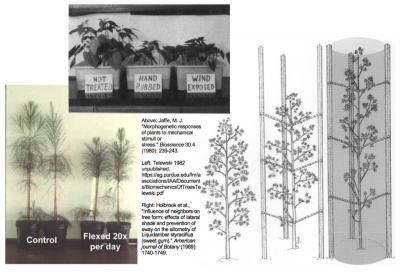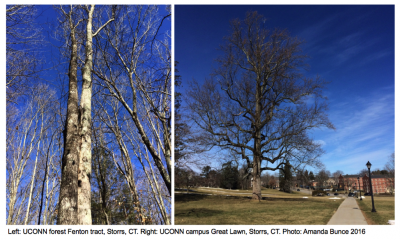The root of the problem, to which we hope Stormwise can be a solution, is the tree/wind dynamic. Wind is the force that sets a tree in motion. A tree set in motion begins to sway with an amplitude and frequency dictated by its own physical properties – its size and shape – as well as the strength and cadence of the wind. Swaying is a tree’s natural method for the dissipation of the energy exerted upon it by the wind, but there exists the dangerous possibility of achieving an amplitude of sway greater than the tree’s elastic capacity to return upright. That’s when trees fall down. That’s when we have tree/utility interaction problems.
We might ask ourselves ‘why does this not happen more often?’ When a big windstorm hits, why don’t more trees succumb to the forces? As it turns out, all plants, trees included, adapt to the patterns of physical stimulation they experience as they grow. Physical stimulation can be anything from wind or sprinkler action, animals brushing the leaves, or being shaken by well-meaning scientists. As a plant experiences these physical agitations, it develops a capacity to withstand them. Dr. M.J. Jaffe, in 1973, coined the term to describe this phenomenon in a paper entitled “Thigmomorphogenesis: the response of plant growth and development to mechanical stimulation.”
Thigmomorphogenesis (thigma being the greek word for touch or handle) has been studied since at least the time of Theophrastus. The Greek philosopher lived around 300 BCE and wrote such works as On Plants and On the Causes of Plants, wherein he describes the stunted height and “rough” or knotted condition of trees growing in exposed areas, versus the erect and undistorted trees in sheltered forests. Since then, much scientific inquiry has been directed at the specific results of thigmomorphogenesis. Just to name a few:
- Ashby et al. (1979) found that shaking sweetgum and maple saplings caused a lessening of total height but not of dry weight of the stem, suggesting that they weren’t truly stunted, but that resources we reallocated.
- Jaffe, in 1980, showed that rubbing the stems of bean plants produced the same responses (shorter, thicker stems) as exposing them to wind. (Fig 1)
- A study on sweetgum saplings tested the effects of staking and shading and found an immobilized, mostly shaded tree allocated more carbon to height growth and in some cases failed to develop even the capacity to remain upright in the absence of supports (Holbrook et al., 1989). (Fig. 1)
- Ostler et al. (1995) showed the effects of bending on developing eucalyptus saplings to include development of stem taper, reaction or tension wood cells, and a bushy branching structure.
- Chehab et al. (2009) highlighted a number of thigmomorphogenic responses including alteration of flowering times, senescence, chlorophyll and hormone levels, pith and stomata structure, phloem transport, electrical resistance, and resistance to various stressors, as well as physical stature of the plants.
Figure 1:

How is this botanical phenomenon useful to the Stormwise project?
Thigmomorphogenesis is the mechanism by which plants develop the capacity to handle the force imposed on them by the wind. We call this developing wind-firmness. The most obvious wind-firm features our northeastern trees develop when exposed to a stronger wind regime include a widened or buttressed base, increased root anchorage, a more tapered stem of lesser height, shorter branches, thicker branch junctions and smaller leaves. This gives exposed trees an overall compact, bushy shape compared to tall slender forest-grown trees (Fig. 2). Some trees (white pines and willows among others) can respond by streamlining, a developmental process that reduces drag on the crown, often by allocation of the heaviest branching to the side opposite the prevailing wind direction. Less noticeably, physical stimulus also triggers changes in cellular arrangement and allocation resulting in greater density and flexibility of the wood in an exposed tree.
Figure 2

The intent of Stormwise is to advocate for the adaptation of a forest management plan that fosters wind-firmness in our roadside forests. Every forest parcel is different and requires a tailored plan, but typically we can approach the plot for thinning, which is a common treatment in timber stands to remove less desirable trees so that resources can be allocated to more desirable ones. In this thinning, we remove any hazardous trees, select for trees with straight stems and symmetrical crowns, and give those the space and exposure they need to develop the wind-firm features we want to encourage. In this manner, we leverage well-used forest management techniques, and the natural processes of the trees themselves, to achieve our rather novel management goals.
Referenced:
- Ashby, W. Clark, et al. “Notes: Effects of Shaking and Shading on Growth of Three Hardwood Species.” Forest Science2 (1979): 212-216.
- Chehab, E. Wassim, Elizabeth Eich, and Janet Braam. “Thigmomorphogenesis: a complex plant response to mechano-stimulation.”Journal of Experimental Botany1 (2009): 43-56.
- Holbrook, N. Michele, and Francis E. Putz. “Influence of neighbors on tree form: effects of lateral shade and prevention of sway on the allometry of Liquidambar styraciflua (sweet gum).” American journal of Botany(1989): 1740-1749.
- Jaffe, M. J. “Morphogenetic responses of plants to mechanical stimuli or stress.” Bioscience4 (1980): 239-243.
- Osler, G. H. R., P. W. West, and G. M. Downes. “Effects of bending stress on taper and growth of stems of youngEucalyptus regnans trees.” Trees4 (1996): 239-246.